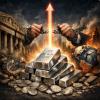
Breaking News
 Brighteon Broadcast News, Jan 7, 2026 - Doctors Replaced by AI...
Brighteon Broadcast News, Jan 7, 2026 - Doctors Replaced by AI...
 US Blockade Of Venezuela Triggers New Spike In Silver Price!
US Blockade Of Venezuela Triggers New Spike In Silver Price!
 Elon Musk Expects True AGI in 2026-2027 and Superintelligence About 2030...
Elon Musk Expects True AGI in 2026-2027 and Superintelligence About 2030...
 They Can't Stop The Unstoppable Rise Of Silver...
They Can't Stop The Unstoppable Rise Of Silver...
Top Tech News
 The First Production All-Solid-State Battery Is Here, And It Promises 5-Minute Charging
The First Production All-Solid-State Battery Is Here, And It Promises 5-Minute Charging
 See inside the tech-topia cities billionaires are betting big on developing...
See inside the tech-topia cities billionaires are betting big on developing...
 Storage doesn't get much cheaper than this
Storage doesn't get much cheaper than this
 Laser weapons go mobile on US Army small vehicles
Laser weapons go mobile on US Army small vehicles
 EngineAI T800: Born to Disrupt! #EngineAI #robotics #newtechnology #newproduct
EngineAI T800: Born to Disrupt! #EngineAI #robotics #newtechnology #newproduct
 This Silicon Anode Breakthrough Could Mark A Turning Point For EV Batteries [Update]
This Silicon Anode Breakthrough Could Mark A Turning Point For EV Batteries [Update]
 Travel gadget promises to dry and iron your clothes – totally hands-free
Travel gadget promises to dry and iron your clothes – totally hands-free
 Perfect Aircrete, Kitchen Ingredients.
Perfect Aircrete, Kitchen Ingredients.
 Futuristic pixel-raising display lets you feel what's onscreen
Futuristic pixel-raising display lets you feel what's onscreen
 Cutting-Edge Facility Generates Pure Water and Hydrogen Fuel from Seawater for Mere Pennies
Cutting-Edge Facility Generates Pure Water and Hydrogen Fuel from Seawater for Mere Pennies
Scientists Demonstrate Success of a Possible 'EpiPen' to Prevent Paralysis From Spinal Cord

The approach was demonstrated in mice by the scientists in Ann Arbor, when the nanoparticles enhanced healing by reprogramming the aggressive immune cells.
"In this work, we demonstrate that instead of overcoming an immune response, we can co-opt the immune response to work for us to promote the therapeutic response," said Lonnie Shea, the Steven A. Goldstein Collegiate Professor of Biomedical Engineering.
Trauma of any kind kicks the body's immune response into gear. In a normal injury, immune cells infiltrate the damaged area and clear debris to initiate the regenerative process.
The central nervous system, which includes the brain and spinal cord, however, is normally walled off from the immune activity by the blood-brain barrier. But a spinal cord injury breaks that barrier, letting in overzealous immune cells that create too much inflammation for the delicate neural tissues. This leads to the rapid death of neurons, damage to the insulating sheaths around nerve fibers that allow them to send signals, and the formation of a scar that blocks the regeneration of the spinal cord's nerve cells.



